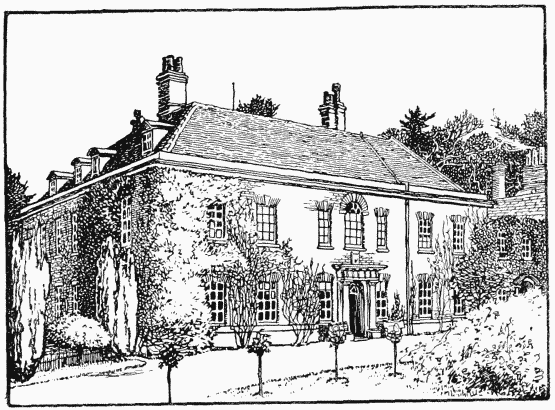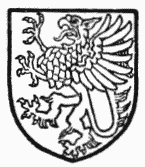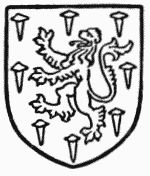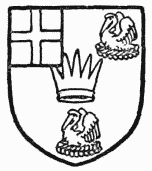A History of the County of Berkshire: Volume 3. Originally published by Victoria County History, London, 1923.
This free content was digitised by double rekeying. All rights reserved.
'Parishes: Pangbourne', in A History of the County of Berkshire: Volume 3, ed. P H Ditchfield, William Page (London, 1923), British History Online https://prod.british-history.ac.uk/vch/berks/vol3/pp303-306 [accessed 19 April 2025].
'Parishes: Pangbourne', in A History of the County of Berkshire: Volume 3. Edited by P H Ditchfield, William Page (London, 1923), British History Online, accessed April 19, 2025, https://prod.british-history.ac.uk/vch/berks/vol3/pp303-306.
"Parishes: Pangbourne". A History of the County of Berkshire: Volume 3. Ed. P H Ditchfield, William Page (London, 1923), British History Online. Web. 19 April 2025. https://prod.british-history.ac.uk/vch/berks/vol3/pp303-306.
In this section
PANGBOURNE
Pandeborne (xi cent.).
The parish of Pangbourne contains 1,940 acres, of which 718 are arable land, 517 permanent pasture and 339 woods and plantations. (fn. 1) The River Thames forms part of the northern boundary, and near it the land lies little over 100 ft. above the ordnance datum. At Bowden Green, however, it rises above 300 ft. The subsoil is alluvium and chalk. The Pang flows through the parish for some distance, joining the Thames at the village of Pangbourne, and the Maidenhatch Brook joins the Pang in the south of the parish near Maidenhatch. The chief roads run east from Pangbourne to Reading, west to Bradfield and south to Tidmarsh. The village lies in the north of the parish on the banks of the Thames, with a bridge connecting it with the Oxfordshire parish of Whitchurch. The right of common of pasture on Shooter's Hill was mentioned in the 16th century. (fn. 2) The chief houses near the village are the rectory and Courtlands, the residence of Miss Baker. Bowden Green is the property of Mrs. Spagnoletti, niece of the late owner, Sir Benjamin Baker, K.C.B., the designer of the Forth Bridge and the Metropolitan railway. To the south is Maidenhatch the property of Col. Walter Thornton, and Bere Court belongs to Mr. George Booth Tate, the lord of the manor. Bere Court is first mentioned in a charter of Bishop Robert Bingham (1229–48) (fn. 3) confirming to Reading Abbey the tithes from it. It was used as a country house for the abbots, who had a chapel there. Tradition says that Hugh Cook, the last Abbot of Reading, was hiding in a secret chamber at Bere Court when he was taken prisoner. The house is mentioned in most of the 16th-century documents relating to the manor (q.v.). In one, dated 1573, the manor of Pangbourne is called the 'manor of Beare.' (fn. 4) The present mansion is a square red brick house of the early 18th century, two stories in height, with a tiled hipped roof. The entrance doorway, which is placed in the centre of the south front, is flanked by small Doric columns supporting their proper entablature, and opens into a large hall communicating with the principal apartments and with the staircase. The offices are contained in a wing on the east side of the house. Some heraldic glass of the 17th century, including the arms of a Stuart Prince of Wales and of Prince George of Denmark, the consort of Queen Anne, are preserved in the staircase window, but of the glass in the chapel which once existed here, described in 1563 as 'painted with images,' (fn. 5) and noticed in detail by Ashmole in the following century, (fn. 6) nothing now remains.

Bere Court, Pangbourne, from the South-west
Clayesmore School is a large private school for boys.
The Great Western railway runs through the north of the parish, with a station at Pangbourne village. Roman remains have been found at Shooter's Hill, drift implements in the Thames, and miscellaneous Anglo-Saxon weapons have also been dug up. (fn. 7)
There are chapels belonging to the Congregationalists and Methodists and a Friends' meeting-house in the parish of Pangbourne.
The following place-names occur in different documents: Pangbourne Bove Down, (fn. 8) Burymarsh, Monken Meade and Hornheath. (fn. 9)
MANORS
Before the Norman Conquest PANGBOURNE was divided into two portions.
The smaller of these, assessed at 2 hides, was said in the Domesday Survey to have 'belonged to the ferm' in the reign of Edward the Confessor, but later was held by Alwold the Chamberlain. Under William the Conqueror it was again attached to the king's ferm by Froger the sheriff. (fn. 10) The larger portion of Pangbourne also belonged to Edward the Confessor, his under-tenant being Baldwin. (fn. 11) Miles Crispin held it in 1086, (fn. 12) and, like all his lands, it afterwards formed part of the honour of Wallingford. (fn. 13) In 1086 one William held it of Miles Crispin. (fn. 14)
There are no records of Pangbourne for nearly a century, but in 1166 the name of Richer of Pang bourne (fn. 15) appears amongst the knights of the honour of Wallingford as holding one knight's fee.
In the 13th century Reading Abbey was said to hold Pangbourne in frankalmoign by the gift of Henry I, (fn. 16) and between 1190 and 1199 Ellis son of Hereward of Pangbourne granted part of his holding in Pangbourne to William Englefield in the court of the Abbot of Reading. (fn. 17) Hence it seems clear that the first holding of 1086 had come to the abbey. Possibly most of the larger holding was also given to the abbey, for there seems to be no other fee in Pangbourne which could represent the whole of this holding. The manor of La Hide, which lay partly in Pangbourne and partly in Purley, (fn. 18) may have originated in the hide in Pangbourne held in 1086 under William the tenant of Miles Crispin by a knight, whose descendants possibly were the family of La Hide. This hide may therefore presumably be excluded from the possessions of the abbey.
The manor of Pangbourne was held by Reading until the Dissolution, when it came to the Crown. (fn. 19) Edward VI appears to have granted it first to the Protector Somerset, (fn. 20) and afterwards, in 1550, to the Earl of Warwick, (fn. 21) afterwards Duke of Northumberland. After his execution Pangbourne again came to the Crown. It was granted by Queen Elizabeth in 1563 to Thomas Weldon, cofferer of the household, and his son Francis, subject to a lease of twenty-one years made by Queen Mary to Sir Francis Englefield. (fn. 22) The latter assigned his lease to Humphrey Burdett, when he fled from England, but the remainder of the lease was taken into the hands of the queen. (fn. 23) Francis Weldon sold Pangbourne in 1613 (fn. 24) to Sir John Davis, a follower and associate of the Earl of Essex. Davis was present at the taking of Cadiz in 1596, and was there knighted by the earl. (fn. 25) In 1600–1 he was implicated in his patron's plot against Queen Elizabeth. He held a post at the Tower, and it was to have been his part to guard the hall in Whitehall Palace so soon as the conspirators had overpowered the queen's guard. (fn. 26) The rebellion was betrayed, and Sir John Davis was tried and sentenced to death in 1600–1. (fn. 27) He was, however, pardoned, and afterwards settled at Pangbourne. He died in 1625, and the manor passed to his son and heir John, who was still a minor. (fn. 28) The second John Davis, who was knighted in 1662, (fn. 29) served as a captain with the Royalist army during the Civil War, but obtained leave to retire from the army in 1644, and compounded for his estate with the Parliament. (fn. 30) He married twice, his first wife being Anne daughter of Sir John Suckling, and his second wife Susan the daughter of Edward Gansell. (fn. 31) He sold the manor in 1671 to John Breedon, (fn. 32) who left it by his will (dated 1685) to his nephew, another John Breedon, (fn. 33) Sheriff of Berkshire in 1700. (fn. 34) The latter died in 1710–11, and was succeeded by his kinsman John Breedon, the son of the Rev. Thomas Breedon, rector of Pangbourne (fn. 35) The last-named John died in 1776, (fn. 36) and the manor passed to his son John Breedon, M.D. (fn. 37) Dr. Breedon died without heirs male, and by his father's will the Rev. John Symonds became the next lord of the manor. (fn. 38) He assumed the name of Breedon, and was living at Bere Court in 1803. (fn. 39) Before 1821 he was succeeded by another John Symonds Breedon, (fn. 40) and in 1847 Edward Augustus Breedon was lord of the manor. (fn. 41) He died before 1883, when Mrs. Breedon owned the manor. It was bought from the Breedons by Reginald de la Bere, who sold it in 1904 to Mr. George Booth Tate, the present lord of the manor. (fn. 42)

Davis of Pangbourne. Azure a griffon or.

Breedon. Sable a lion argent with eight passion nails or in the border.
The Abbots of Reading presumably held in Pangbourne the very extensive rights that were granted to them by Henry I and the succeeding kings for all their possessions. In the 17th century the lords of the manor exercised the rights of free warren and free fishery, and they also held the view of frankpledge and had the wardships and marriages, escheats, the goods and chattels of felons and waifs and strays that fell to them in the manor. (fn. 43)
MAIDENHATCH
MAIDENHATCH (Maydehethe, Maydenheth, xiii cent.) was held of the abbey of Reading as of the manor of Pangbourne. (fn. 44) It is first mentioned in the 13th century when Hereward of Maidenhatch and his two brothers Peter and William were witnesses of a charter contained in a cartulary of Reading. (fn. 45) The manor may be identified with the land held by Walter of Maidenhatch, who in 1281 paid a subsidy of 22s. on his goods. (fn. 46) In 1289 he settled tenements in Maidenhatch, Bradfield and Pangbourne on himself and his wife Alice. (fn. 47) William of Maidenhatch was living in the reign of Edward III, (fn. 48) but no subsequent owner of the property appears till 1410–11, when Gilbert Holloway held the manor of Maidenhatch, (fn. 49) and his name appears in the list of gentry in the county in 1434. (fn. 50) He was succeeded by his son Thomas, (fn. 51) whose son Alexander was in possession in 1497–8. (fn. 52) Alexander settled the manor on himself and his wife Elizabeth. (fn. 53) The latter survived her husband and held the manor at the time of her death in 1539. (fn. 54) It passed to their grandson and heir John, a minor, whose wardship was granted by Henry VIII in 1541 to John Stafford, together with an annuity of £8 from the manor and other tenements. (fn. 55) Over forty years later John Holloway, on an occasion subsequent to the marriage of his son Thomas with Margaret daughter of John Buttes, settled Maidenhatch Manor on himself and his wife Helen for life, with reversion to his son and daughter-in-law and their heirs male. (fn. 56) He died at Pangbourne in 1593, (fn. 57) and his widow claimed the manor in 1596 against Francis Weldon, then lord of the manor of Pangbourne, (fn. 58) who had seized it on the death of John on the ground that the heir was a minor holding of him by military service. A rental of the manor of Pangbourne of earlier date describes Maidenhatch as held freely of the lords of Pangbourne by knight service. (fn. 59)

Pottinger. Vert an Eastern crown or between three pelicans argent and a quarter argent with a cross gules therein.
In 1595 Margaret Buttes, relict of Thomas Holloway, married Richard Pottinger at Burghfield. Thomas Holloway having predeceased his father, the manor passed on the death of John Holloway to his grandson John Holloway, justice of the peace for Berkshire in 1601. (fn. 60) In 1615, however, John sold it to his mother and her second husband Richard Pottinger of Burghfield. (fn. 61) They were succeeded by their son and grandson, both Richard Pottinger (fn. 62) by name. The third Richard Pottinger was holding the manor in 1686, (fn. 63) and in 1716 it was still in his hands or had passed to a fourth Richard Pottinger. (fn. 64) Another estate in Maidenhatch was held by the Breedons, lords of Pangbourne, who are said to have held the manor uninterruptedly from 1671 to 1894, when Colonel Walter Thornton, J.P., the present owner, bought the property. (fn. 65)
On the king's holding in Pangbourne in the Domesday Survey there was a mill worth 20s. a year, (fn. 66) and on that of Miles Crispin another worth 10s. a year. (fn. 67) One mill came with the manor to Reading Abbey. It was held in the early 13th century by John son of Hugh de Bendinge, but after his death before 1230–7 its possession was disputed between the children of his first and second wife. (fn. 68) The mill was afterwards held by the lords of Tidmarsh Manor (q.v.), John Tidmarsh dying seised of it in 1382. (fn. 69) In the 15th century Robert Leynham and his wife Margaret held the manor and mili and were succeeded by their son Hugh. (fn. 70) Tidmarsh came into the possession of Sir Peter Vanlore in the 16th century, (fn. 71) and it is possible that the mill at Pangbourne may have been one of the three water-mills which were divided between his son and daughters and their descendants. (fn. 72) Another of these mills may have been Maidenhatch Mill, which stood in the meadows by the dairy. (fn. 73) At the present day there is one mill at Pangbourne.
CHURCH
The church of ST. JAMES THE LESS consists of a chancel, nave, with north vestry and organ chamber, north aisle, west tower and south porch.
The church was entirely rebuilt in the Early Decorated style in 1868 with the exception of the brick west tower erected in 1718. The material is flint with stone dressings.
The west tower is of brick with cut-brick quoins and is divided by string-courses into three stages. The tower arch is semicircular, and the west window of the ground stage is a plain square opening with unmoulded mullions and transoms of wood. In the ground stage of the tower are hung a large number of hatchments of the Davis family with various alliances. The ringing chamber has small circular windows on the north, west and south. The belfry is lighted on all four sides by windows with depressed three-centred heads divided into two pointed lights by a central mullion of wood.
Reset in the north wall of the organ chamber is the elaborate monument of Sir John Davis, who died in 1625, containing the effigies of himself and his two wives within a pedimented recess cut back into the wall, while below them, in a niche in the base, are the kneeling effigies of a son and daughter. On either side of the recess, which has a four-centred arch with straight sides, are coupled Tuscan columns with their appropriate entablature, the frieze of which is ornamented with strap work. The cornice, frieze and architrave are continued over the arch of the recess, the cornice of this portion of the entablature being supported by carved brackets. In the pediment is a blank shield. An oval tablet over the centre of the recess bears the inscription: 'Under | part of this Monumt lieth | ye bodie of Sr John Davis Kt who | received ye honour of Knighthood | and Bannerett at ye taking of | Cales in Spain in ye reigne | of Q: Aeliz: He died May ye | 14. 1625 in ye 63 yeare | of his Age.' Another slab commemorates Martha (mar. (1) Sir George Southcott, (2) William Clagett, d. 1661), Anne (mar. Sir John Davis, d. 1659) and Mary (d. 1658), daughters of Sir John Suckling.
There is a ring of five bells, all by Abraham Rudhall of Gloucester, 1720.
The plate includes a cup of 1677 with cover paten inscribed 'The gift of Mrs. Mary Stavely,' a large paten of 1698, a cup of 1737 and a flagon of 1692.
The registers begin in 1556.
ADVOWSON
The advowson of the church of Pangbourne was probably granted to Reading Abbey with the manor, as it is first mentioned in a confirmatory charter of Archbishop Hubert Walter (1189–1205). (fn. 74) In a papal dispensation of 1257, however, the church was said to be attached to one of the prebends of Salisbury Cathedral, (fn. 75) but there is no mention of this in any later document. After the Dissolution the advowson came to the Crown. Queen Elizabeth granted it to Thomas and Francis Weldon in 1563. (fn. 76) The new patrons seized the whole rectorial estate in 1578, but after two years Thomas Shilborne, the then incumbent, complained to the Privy Council, and the Bishops of London and Salisbury and Dr. Hamon were ordered to summon the parties to the dispute. (fn. 77) The advowson of the rectory passed until lately with the manor of Pangbourne. (fn. 78) In 1626, however, during the minority of the younger Davis, John Sanders presented, (fn. 79) and in 1647 (fn. 80) the Crown exercised the right instead of John Davis. In 1688 Thomas Brumsted and Zacharias Sedgwick presented, (fn. 81) and in 1726 Anthony Blagrave shared the presentation with John Breedon, (fn. 82) the lord of the manor. It was apparently sold by the Breedons, and Mr. C. Minchin is now the patron of the living.
No vicarage was ever instituted at Pangbourne, but part of the tithes in the parish were assigned to the abbey of Reading. Bishop Bingham confirmed to the monks both great and small tithes from Bere Court and a pension of £1 12s. 8d. (fn. 83) This pension, payable by the parson, is again mentioned in 1291, (fn. 84) and was assigned to the support of the sacrist of the abbey. (fn. 85) Edward VI granted it to the Earl of Warwick in 1550, (fn. 86) although he reserved the advowson, but it is not mentioned in Queen Elizabeth's grant to the Weldons of the manor and advowson.
CHARITIES
Breedon's School, founded by will of John Breedon, dated 24 March 1685, is regulated by a scheme established by an order of the Charity Commissioners 30 October 1900. The trust estate consists of the school buildings and master's house, a house let at £35 a year, the sum of £1, 904 10s. consols, producing yearly £83 3s., representing the redemption in 1896 of a rent-charge of £40 originally devised by the founder and certain arrears and accumulations.
In 1826 the Rev. John Symonds Breedon, by will proved in the P.C.C. 27 September, bequeathed £150 in trust that the income be distributed in coal to twenty of the poorest housekeepers about Christmas. The trust fund with accumulations consists of £178 11s. 8d. consols, producing £4 9s. a year. Each recipient receives about 5 cwt.
In 1856 William Downing by deed gave £166 10s. consols, and declared that the interest thereof should be applied in the distribution of coals among those receiving outdoor relief and of the age of sixty years and upwards. The charity is regulated by a scheme of the Charity Commissioners of 29 April 1890.
The several sums of stock are held by the official trustees.